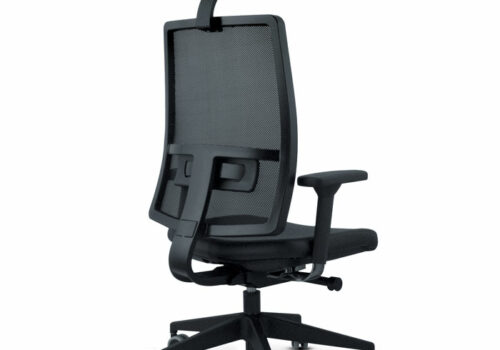Mechanism for ergonomic office chair: 7 types of mechanisms
Have you ever thought about how many hours we spend in front of a desk? All those who, like us, work in the office, usually spend most of their time seated. Therefore, to maintain our well-being it is essential to have a correct posture. This is the reason why, in 2008 the decree law 81 was established which declared that a “video terminal operator” (ie “someone who uses the computer for more than 4 hours a day”) needs a swivel seat on castors, with adjustable height, lumbar adjustment and backrest inclination movement mechanism.
The adjustment mechanism is the “heart” of every office chair, one of the main components of the office chair. Too often, however, the adjustment controls, which are located under the seat, are used roughly or are not used at all. In this short article we want to tell you about the main mechanisms that our chairs can be equipped with and their difference.
Mechanisms for ergonomic chairs
A common office chair differs from an ergonomic chair which is equipped with a series of adjustments that allow you to keep the body in a correct posture.
The adjustment takes place through a particular mechanism that allows movements and flexibility.
In ergonomic office chairs, the mechanisms that adjust the position of the backrest and seat can be of different types.

Permanent contact mechanism
This is generally the cheapest mechanism. It allows you to keep the backrest in contact with the body and therefore guarantees the right back support for those who spend many hours at the desk.
The inclination of the backrest is adjustable through a lever under the seat or through a knob, which also allows you to lock the chosen position. The seat position is not adjustable.
Tilt mechanism
This mechanism is often typical of executive chairs. It allows you to swing the backrest and move the seat forward or backward, in a 1: 1 ratio, thus keeping the angle fixed.
The adjustment is done through a knob, usually placed under the seat. Usually the backrest can be locked in a vertical or inclined position.
Every tilting mechanism can be monoblock or multiblock type:
- in the first case, it is possible to simultaneously adjust the tension on the seat and the inclination of the seat and backrest from vertical to inclined position;
- in the multi-block option, on the other hand, four intermediate blocking positions are available.
The swing is in fact used in armchairs that have a single structure, in which the seat and back are united in a single “monocoque”.
This is why this mechanism is normally used in armchairs for sporadic use and are not recommended for professional use.
Synchronized (or synchro)
It is considered one of the most advanced and performing mechanisms because both the backrest and the seat follow the movement of the body.
The seat has a distinct but synchronized movement with respect to the inclination of the backrest, in a 3: 1 ratio.
In detail, at each 30% inclination of the backrest, the seat rises by 10%, increasing user comfort because it helps to unload the weight of the spine on the chair.
The backrest is adjusted by means of a knob, located under the seat, which allows you to find the solution of maximum comfort based on the weight of the person.
Self-weighting synchro mechanism
Some ergonomic chairs are equipped with a self-weighting synchro mechanism, which differs from the standard because the adjustment takes place automatically, without the use of knobs.
This mechanism usually has a lower cost than the others.
Thus, if you want to protect your spine, improve your efficiency and the quality of your work, come and discover our ergonomic chairs. We will be able to satisfy every need.
Asynchronous mechanism
The asynchronous mechanism is a mechanism that allows you to adjust the backrest and seat independently.
This mechanism therefore allows you to find the optimal static position of use for sure, but does not allow you to “rock”, that is, it does not allow a dynamic use of the chair.
In the asynchronous mechanism we tend to have the following adjustments:
- seat height
- seat tilt
- backrest inclination
The asynchronous mechanism is suitable for professional and intensive use because it still allows excellent adjustment of the static sitting position.
Seat slider
The seat translation mechanism allows you to adjust the position of the seat. Therefore to make the seat of the chair more or less deep.
This office chair component is indicated by the UNI EN1335 standard for class A seats and is recommended for “multi-user” chairs.
Multi-user chairs are chairs on which several people of various heights can sit.
Sometimes the synchronous mechanism complements this mechanism.
While in other cases it is a separate mechanism; it can therefore be optional and can be added to any other mechanism (oscillating, synchro or asynchronous).
Seat tilt or forward tilt mechanism
With the forward tilt mechanism, on the other hand, the seat of the chair can also be tilted a few degrees forward. In this way the angle between the torso and the upper leg can be slightly more open than 90 °.
In a dynamic chair, this greater opening of the bust / leg angle allows to improve blood circulation and therefore to avoid the discomfort of weighting the legs.
The forward tilt mechanism is usually integrated in medium-high range mechanisms and a special lever allows for this adjustment.
Some movements, on the other hand, already have this function integrated.
Grendene’s ergonomic chairs are equipped with the best mechanisms.


